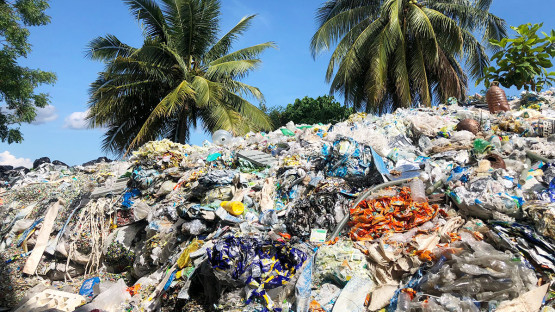
If you would like to learn more about the IAEA’s work, sign up for our weekly updates containing our most important news, multimedia and more.
Plastic Pollution: Recycling with Radiation to Protect the Environment
Puja Daya

Eight billion tonnes of plastic have been produced since 1950. Much of it lies unrecycled in dumps, in the ocean or on beaches. (Photo: M. Gaspar/IAEA)
Over 5000 kilometres from the nearest major land mass, Henderson Island is perhaps the most isolated place on earth. Yet, despite a complete absence of people, this paradisical South Pacific island is awash with over four billion plastic pieces and particles. The litter lining Henderson’s beaches is not only unsightly, but also deadly to the marine life that is choked or trapped by it. Plastic debris like this is just one example of the fate of over eight billion tonnes of plastic that have been produced since 1950.
The IAEA is working with experts from all over the world to change that fate and protect marine life and the environment from plastic pollution. With its partners, the IAEA is researching and developing ionizing radiation techniques to affordably reprocess and recycle plastics. These techniques involve using electron beam accelerators to irradiate post-consumer plastics to recycle them and to more easily reform them into other products.
“ Irradiating materials is no longer just a manufacturing tool, but also a recycling tool, so the ionizing radiation techniques used to modify polymers are relevant for plastic waste processing.
The technique is promising because it is not entirely new and has a long and successful story. Irradiated polymers are found all around, from the rubber tyres on a car to hot water pipes and food packaging. “If we can use this technology in industrial applications to gain new features in plastics, there is nothing stopping us also using irradiation to reform and restructure plastic to improve its recyclability and reduce the amount of plastic disposed,” said Celina Horak, Head of the Radioisotope Products and Radiation Technology Section at the IAEA.
Plastics are made up of different types of polymers — a substance made of long chains or networks of repeating groups of atoms called monomers. The irradiation of polymers produces different effects on the polymers that are beneficial for recycling, reducing and reusing plastic waste.
A new IAEA coordinated research project to develop the use of ionizing radiation in recycling polymer waste is spearheading research in this area. “Irradiating materials is no longer just a manufacturing tool, but also a recycling tool, so the ionizing radiation techniques used to modify polymers are relevant for plastic waste processing,” said Bin Jeremiah Barba, Science Research Specialist at the Philippine Nuclear Research Institute. Her institute is just 1 of 18 countries, which are collaborating to consider how radiation processes such as cross-linking, chain scission, grafting and other surface modification can help countries to develop more affordable and accessible recycling methodologies.
Cross-linked polymers
The process of cross-linking refers to the use of electron beam irradiation to form bridges between polymer strands. By connecting polymer strands together, the properties of the material are enhanced, and can be used to create longer lasting, more resistant, better quality products. This is common practice in the creation of vehicle tyres, as it allows manufacturers to reduce the size and thickness of the rubber — reducing raw material and production costs, and making the product more sustainable.
Degrading polymers
Irradiation is used in almost the opposite way through chain scission — a process in which polymers are cut up or ‘degraded’. “This process makes materials more brittle and easier to be ground into finer polymers. For example, polytetrafluoroethylene, a chemical coating more commonly known by its brand name, Teflon, is degraded and then used in motor oil lubricants and additives for inks,” said Olgun Güven, a radiation polymer expert at Hacettepe University who is leading efforts in Türkiye. Under the coordinated research project, experts are considering how chain scission can be used in chemical recycling, in which a product is broken down into its basic chemical form to generate new raw materials or fuel. Chain scission for recycling could massively enhance the production of new products from single use polymers, he said.
Grafting polymers
Grafting is the process of growing a tailored short polymeric chain on the surface of another polymer in order to modify its properties. The same technique can be used to combine polymers that would typically be incompatible together, for the easier remoulding and restructuring of waste.
These techniques are just a few ways in which the IAEA is exploring the use of ionizing radiation for recycling waste from plastic. “The very tools used in industry can be applied to recycling and are an affordable and accessible part of the solution to reduce the plastic waste harming our environment,” said Horak. She said that the ongoing coordinated research project will improve and validate this plastic recycling technology and help determine its feasibility for use in countries. It will also develop a plan for transferring the knowledge and turning it into action.
To improve capabilities worldwide in the application of innovative radiation techniques for reducing plastic waste by recycling it, the IAEA launched the Nuclear Technology for Controlling Plastic Pollution (NUTEC Plastics) initiative in 2021. The initiative is dedicated to helping countries use various nuclear techniques. It provides science-based evidence to characterize and assess marine microplastic pollution, while also demonstrating the use of ionizing radiation in plastic recycling, transforming plastic waste into reusable resources.
NUTEC Plastics involves coordinated research projects that help to provide precise scientific data to inform plastic pollution policies, strengthen methodology to track plastics and improve the scalability of the recycling technology. IAEA technical cooperation projects in the initiative offer researchers equipment and training to transfer knowledge and facilitate plastic recycling projects. The development of guidelines will help countries set up and establish facilities to use nuclear techniques to tackle plastic pollution.





